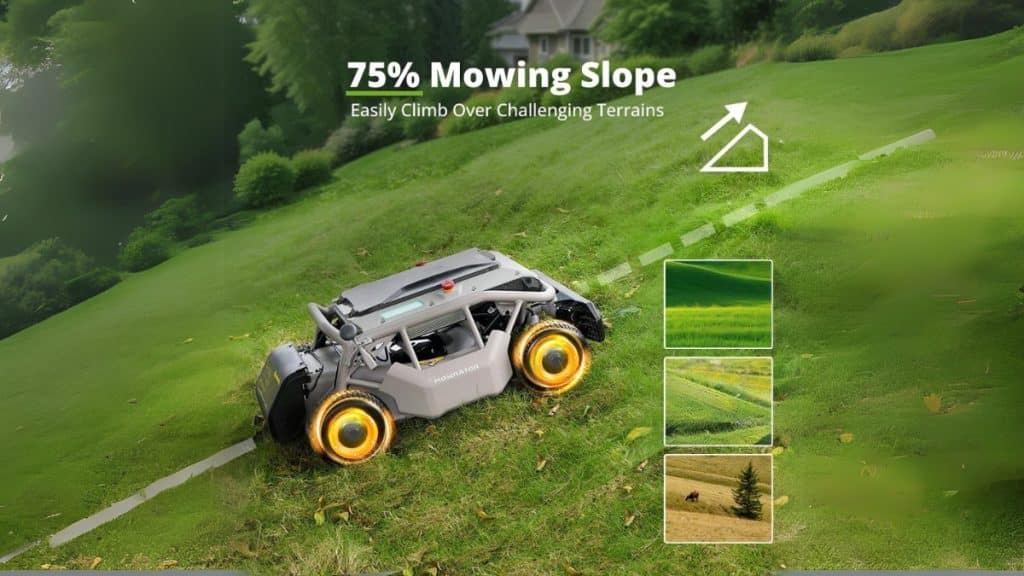Regarding tackling hilly terrain, choosing the right mower for hills can make all the difference. Zero turn mowers are popular for their maneuverability and speed, but are they truly effective on slopes? This article explores the pros and cons of using zero turn mowers on hills, helping homeowners make informed decisions for their landscaping needs.
Overview of Zero Turn Mowers
Zero turn mowers feature a unique design that enhances their maneuverability and efficiency. The steering system consists of two independent levers, allowing operators to turn 180 degrees in place. This design excels in tight spaces, making it suitable for landscaping around trees, flower beds, and gardens.
Zero turn mowers often come with powerful engines, typically ranging from 15 to 35 horsepower. They can cut grass at speeds between 6 to 12 miles per hour, significantly reducing mowing time. The cutting decks vary in size, commonly between 42 to 72 inches, accommodating different yard sizes and configurations.
These mowers also provide adjustable cutting heights, typically between 1 to 4 inches. This feature allows homeowners to customize the grass height based on their preferences and the specific type of grass. Additionally, many zero turn mowers include additional attachments, such as baggers, mulchers, and spreaders, enhancing their versatility for different landscaping tasks.
Overall, zero turn mowers combine speed, efficiency, and agility, making them a popular choice among homeowners seeking effective lawn care solutions.
Benefits of Using a Zero Turn Mower
Zero turn mowers offer several advantages, particularly when tackling hilly landscapes. Their design and features contribute to improved maneuverability and cutting efficiency.
Maneuverability on Slopes
Zero turn mowers excel in maneuverability on slopes due to their unique steering system. Independent levers allow for precise control, enabling sharp turns and navigation around obstacles. This capability reduces the risk of slipping or losing control, which is often a concern with traditional riding mowers on inclines. The compact design enhances stability on uneven terrain, making it easier for users to handle challenging landscapes effectively.
Efficiency in Cutting Time
Cutting time significantly decreases with zero turn mowers. Their powerful engines, ranging from 15 to 35 horsepower, enable faster mowing speeds between 6 to 12 miles per hour. This speed, combined with a cutting deck size of 42 to 72 inches, allows for broader swathes of grass to be cut in less time. Adjustability in cutting heights from 1 to 4 inches provides flexibility, ensuring optimal grass length and health with each pass.
Challenges of Mowing on Hills
Mowing on hills presents unique challenges that require careful consideration to ensure safety and efficiency.
Stability and Safety Concerns
Stability remains a primary concern when operating zero turn mowers on inclines. These mowers, while agile, can become unstable on steep slopes. The risk of tipping increases if the mower is not operated correctly. It’s crucial to maintain a low speed, make gradual turns, and avoid sudden movements. Proper weight distribution also plays a role; models with a lower center of gravity improve stability. Operators should prioritize safety by wearing seat belts and following manufacturer guidelines to minimize risks.
Terrain Considerations
Terrain significantly impacts mowing effectiveness. Different types of hills, such as steep slopes or uneven ground, require specific approaches. Steep inclines might lead to traction issues, causing the mower to slip or slide. Mowers with turf-specific tires improve grip and stability on slick or loose surfaces. Additionally, operators should assess the terrain before mowing, identifying any rocks, roots, or obstacles that could pose hazards. Multiple passes may be necessary to achieve an even cut on uneven surfaces, prolonging the mowing process.
Zero turn mowers can be effective on hills, but their performance largely depends on terrain type and operator technique.
Performance on Steep Grades
Zero turn mowers excel on gentle slopes due to their agility and high maneuverability. However, steep grades pose risks. Uneven weight distribution can lead to instability, increasing the potential for tipping. Operators should observe the degree of the slope, as zero turn mowers may struggle with grades exceeding 15 degrees without proper technique. Adequate traction on wet grass presents additional challenges, so mowers equipped with turf tires offer better grip.
Recommendations for Use
When using a zero turn mower on hilly terrain, operators should adhere to these guidelines for safety and efficiency:
- Maintain low speeds to improve control and reduce tipping risk.
- Make gradual, wide turns to avoid sudden shifts in weight.
- Check balance before starting; keeping the mower’s center of gravity low improves stability.
- Evaluate the terrain for hazards such as rocks and uneven surfaces.
- Consider cutting in a straight line up and down the slope rather than across to minimize slipping.
Following these recommendations helps maximize the effectiveness of zero turn mowers on hilly landscapes while ensuring operator safety.
Conclusion
Zero turn mowers can be a solid choice for homeowners dealing with hilly terrain. Their maneuverability and cutting efficiency make them appealing for maintaining lawns on gentle slopes. However operators must remain cautious on steeper inclines due to stability concerns and the risk of tipping.
By adhering to safety guidelines and evaluating the terrain before mowing, users can maximize the benefits of these mowers while minimizing potential hazards. With the right approach and careful operation, zero turn mowers can effectively tackle the challenges presented by hilly landscapes, making lawn care more efficient and enjoyable.
